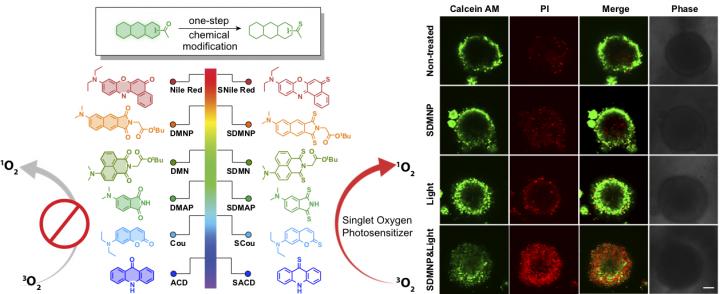Replacing one atom in molecule gives it the power to destroy tumor cells when light-activated

Credit: Xiao Lab/Rice University
HOUSTON – (June 11, 2020) – A Rice University lab’s project to make better fluorescent tags has turned into a method to kill tumors.
Switching one atom in the tag does the trick.
Rice chemist Han Xiao and his colleagues found that replacing a single oxygen atom with a sulfur atom in a common fluorophore turns it into a photosensitizing molecule. When exposed to light, the molecule generated reactive oxygen species (ROS) that destroyed breast cancer cells in the lab.
The study led by co-lead authors Juan Tang and Lushun Wang, both Rice postdoctoral researchers, appears in the Royal Society of Chemistry flagship journal Chemical Science.
This method of photodynamic therapy is already in use, as light-triggered molecules are known to generate cytotoxic ROS. Most current photosensitizers require the incorporation of heavy atoms, but they are difficult and costly to synthesize and remain toxic in the dark, potentially damaging healthy cells, Xiao said.
The Rice lab’s one-step compounds have no heavy atoms, yield a high ratio of ROS when triggered and shut off when the light is turned off. The lab’s various thio-based fluorophores absorb light in visible to near-infrared wavelengths that penetrate up to 5 millimeters into tissues.
“This work comes through our previous study to make better fluorogenic dyes,” Xiao said. “That was a totally new discovery, but once we went deeper into the mechanism, we found that our thio-based fluorophores can lead to a dramatic generation of singlet oxygen when excited with light. This is the real mediator.”
For testing, the researchers combined their photosensitizers with trastuzumab, an antibody used to target and treat early and advanced breast cancer. The combination showed “robust cytotoxicity” against HER2-positive (cancerous) cell lines but almost no activity against HER2-negative cells.
Xiao said the experiments showed their photosensitizers targeted both monolayer cancer cells and multicellular tumor spheroids. “We think a big application for this photosensitizer will be skin cancers,” he said. “It should be easy for light to penetrate basal cell carcinomas on the surface.”
The researchers noted solar cells, photocatalytic applications and organic chemistry may benefit from their photosensitizers.
###
Rice graduate students Axel Loredo and Carson Cole are co-authors of the paper. Xiao is the Norman Hackerman-Welch Young Investigator, the Cancer Prevention and Research Institute of Texas (CPRIT) Scholar in Cancer Research and an assistant professor of chemistry.
CPRIT, the Robert A. Welch Foundation, the National Institutes of Health, a John S. Dunn Foundation Collaborative Research Award and a Hamill Innovation Award supported the research.
Read the abstract at https:/
This news release can be found online at https:/
Follow Rice News and Media Relations via Twitter @RiceUNews.
Related materials:
One-atom switch supercharges fluorescent dyes: http://news.
Xiao Lab: http://xiao.
Department of Chemistry: https:/
Wiess School of Natural Sciences: https:/
Images for download:
https:/
The design of thio-based photosensitizers, at left, by Rice University chemists shows promise for photodynamic cancer therapy, among other applications. One thiocarbonyl substitution — trading an oxygen atom for a sulfur atom — of a variety of fluorophores can dramatically enhance their ability to generate reactive oxygen species that kill cancer cells. At right, images of multicellular tumor spheroids treated with photosensitizers and light (in the bottom row) show how the compounds, when excited by light, damage the cells. (Credit: Xiao Lab/Rice University)
https:/
CAPTION: Han Xiao. (Credit: Rice University)
Located on a 300-acre forested campus in Houston, Rice University is consistently ranked among the nation’s top 20 universities by U.S. News & World Report. Rice has highly respected schools of Architecture, Business, Continuing Studies, Engineering, Humanities, Music, Natural Sciences and Social Sciences and is home to the Baker Institute for Public Policy. With 3,962 undergraduates and 3,027 graduate students, Rice’s undergraduate student-to-faculty ratio is just under 6-to-1. Its residential college system builds close-knit communities and lifelong friendships, just one reason why Rice is ranked No. 1 for lots of race/class interaction and No. 4 for quality of life by the Princeton Review. Rice is also rated as a best value among private universities by Kiplinger’s Personal Finance.
Jeff Falk
713-348-6775
[email protected]
Mike Williams
713-348-6728
[email protected]
Media Contact
Jeff Falk
[email protected]
Original Source
https:/
Related Journal Article
http://dx.




